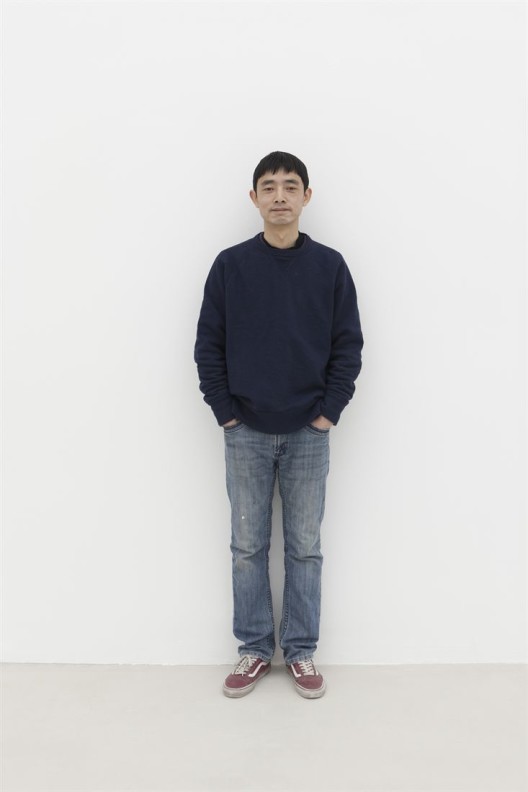Gallery Yang (Warehouse No. 20, East of 798 Art Zone, No.2 Jiuxianqiao Road, Chaoyang District, Beijing, China), Mar 7– Apr 19, 2015
In 2008, Lee Ufan created a sculptural installation based on a 1979 draft entitled “Space Planning”; the piece entitled “Relatum-Silence in Seoul” is composed of a 2.3m by 3m rectangular steel sheet and a 70 cubic centimeter piece of stone. Resting against the wall, the four sides of the steel sheet appear uneven, forming an irregular square silhouette which blocks the viewer’s perspective, while the horizontal and vertical lines of the wall and floor segment the area in front of the viewer into an extensive grid.
Zeng Hong’s paintings are absent of stone, but irregular frames, as well as grids and color blocks segmented by horizontal and vertical lines, do appear. The square frames are not entirely regular or straight; they resemble Lee’s steel sheet—tilted and leaning against the wall. These seemingly abstract paintings do not originate from abstract intent, and are in fact the product of very careful and specific brushwork. Almost every painting has been primed with several layers of paint; each thin layer is a different color, and the thinness of the paint gives the background of each painting a sense of chaos. Framed within these backgrounds are areas delineated with black borders; these spaces are then filled in with different colors. Much like the irregularity of the square frames, the colors have been mixed with grey and are themselves irregular. Colors within the square frames tend to be pale, while the composition has been sliced into countless tiny squares resembling a mosaic. The miniature blocks of color are similar in hue, but are not identical. The surface and finish of each painting is not smooth or ornate, and resonate with the square frame’s irregularity and unsteadiness. These frames appear to be formed of four haphazard lines drawn casually on the canvas, and the viewer’s focus is intentionally steered towards the area within; but the dark, claustrophobic colors do not seem to declare this zone as an area of focus. The meticulously and mechanically drawn grids act as an invasive force within the compositions, evincing a gesture of refusal. Though upon first impression the lines, shapes, and colors within the paintings appear to be clearly delineated, a sense of unease soon arises due to the qualities listed above. This is perhaps the result of the artist’s self-examination of the idea of “the canvas as a frame”.
From “Shutter Doors” (2009) to “Wave” (2010) to the “Still Life” (2014) series on show in this exhibition, the representational paintings’ narratives and patterns are gradually consumed by an ambiguous gray-scale. Colors and lines which were once bright and clear become muddled, becoming layered grids of color blocks. The narrative of the artist’s creative journey is quite clear in the transition from barely visible scenes of the city at night in “Pure Black” to nearly obsessive experimentation with similar pale hues in “White Blocks on Red” (2013), “Three White Blocks” (2013-2014), and “The Form of White No. 2”, to a more resolute position in paintings like “Black on Gray” (2014).
So what anxieties lie behind the surface of the paintings? On some level, an answer may be found in the three-channel video installation “Sequence”. The work is composed of a series of shots taken at a factory; the camera has been placed on a piece of manufacturing equipment to capture repetitive motion. The bankruptcy of this factory where Zeng Hong worked for eight years also gave way to the artist’s professional career. Zeng was not employed here to operate machinery; his training in painting helped him secure a role teaching art at the factory. This experience affected Zeng Hong immensely: the artist writes, “Here, labor is not a form of Chinese spiritual philosophy, but rather a mechanism of commercial exchange and physical discipline. The workers are not perfecting themselves with the repetition of their movements; they are constantly aware of resistance.” The projection of a rotating ruler and the two monitors stacked upon a trolley are frail attempts at recreating the factory scene. Trembling frames, tilted lines, and subdued colors not only symbolize the discipline inherent in labor; they also attempt to understand, reflect upon, repeat, acquire, and resist.

曾宏个展现场,杨画廊

曾宏个展现场,杨画廊

曾宏,《灰色上的黑色》,布面丙烯,275 x 150 cm,2013-2014

曾宏,《静物 No.8》,布面丙烯,160 X 120 cm,2014

曾宏,《绿色上的红色》,布面丙烯,双联,160 X 120 cm,2013-2014

曾宏,《三块白色》,布面丙烯,275 x 150 cm,2013-2014
